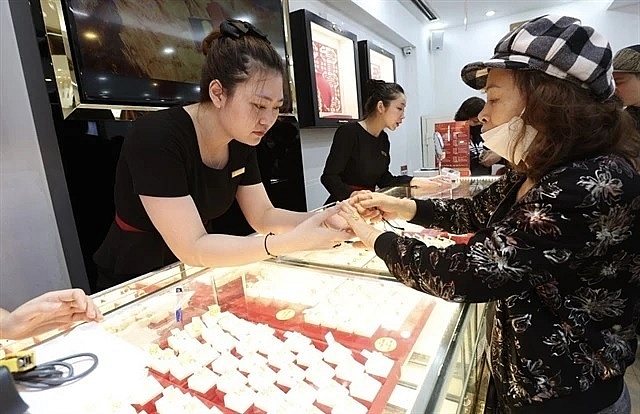INTERNATIONAL INVESTMENT
AND PORTAL
Hanoi - Gold prices reached a historic peak last week after consecutive auction sessions held by the State Bank of Vietnam (SBV) were met with lukewarm enthusiasm.
 Customers at a gold shop in Hanoi. (Photo: VNA)
Customers at a gold shop in Hanoi. (Photo: VNA)
The highly anticipated auction on April 22, the first gold auction by the central bank in 11 years, was postponed due to a lack of interest from gold traders.
The rescheduled auction, held on April 23, only managed to sell 3,400 taels, falling far short of the 16,800 taels on offer.
Traditionally considered a safe haven for investors, gold has proven to be a highly profitable investment channel since the beginning of 2024. Since then, the SBV has announced two other auctions as prices for the precious metal continued to climb, reaching nearly 86 million VND per tael for gold bars and 75 million VND for gold rings, the highest recorded in history, sparking a gold rush among traders and the public alike, with hopes of making a profit.
"Fluctuations in SJC gold bar prices in recent months have mirrored the global market. The central bank has taken measures to address the issue, initially by holding auction sessions to supply the market with additional gold," said SBV Deputy Governor Dao Minh Tu.
However, the market reception of the auctions has largely been underwhelming, with three out of four sessions called off due to insufficient bidders.
Explaining the situation, economists and industry insiders cited reasons behind the central bank's failed auctions, including violent market fluctuations in recent months, excessive risks placed solely on traders, and high initial asking prices at nearly market prices, leaving traders with razor-thin profit margins.
They noted that the underlying issue in the market remained unchanged, as supply failed to keep up with demand since traders were no longer allowed to import gold since May 2012, in an attempt by the SBV to reduce the precious metal's influence on the economy.
Economist Nguyen Tri Hieu suggested that to stabilise gold prices, the SBV's auctions would need to be much more successful in attracting bidders and supplying the market with a larger quantity of gold. Hieu also proposed reconsidering the monopoly of the SJC national gold brand to create a fairer playing field among traders.
Additionally, he suggested that the central bank should step back as the sole importer of the precious metal, handing over the reins to reputable and established traders, who would operate under the SBV's supervision.
Nguyen Duc Do, a professor from the Vietnam Academy of Finance in Hanoi, suggested that the central bank should consider setting up a mechanism to intervene in the market when the difference in gold prices between the domestic and global market becomes too significant.
For example, the SBV could import gold when the domestic price is 2 per cent higher than the global price. Conversely, the central bank could buy gold from the market when the domestic price decreases by more than 2 per cent of the global price.
Dinh Nho Bang, Vice Chairman and Secretary-General of the Vietnam Gold Traders Association, stated that the large price difference was due to the absence of supply while demand continued to grow over the last ten years.
Domestic gold prices have been keeping a lead of 16-17 million VND on global prices, which stayed around 2,300 USD per ounce as of May 4.
He noted that the SBV's auction, while still welcomed by the market, was merely a temporary fix and should not be overleveraged, as the gold was drawn from the country's reserves intended for emergency needs.
Moreover, with the SJC monopoly in place, businesses and individuals may be inclined to hoard gold, further reducing capital available for production and investment, thereby negatively affecting the economy as a whole. Economists and industry insiders have voiced their support for another approach to regulating the market, citing the successful example of India, a country that had a similar gold import monopoly in the past.
After experiencing some initial success, the country later abolished the monopoly. In 1997, India officially listed gold on the Multi Commodity Exchange of India, laying the foundation for the digitalisation of gold assets in 2007. In 2015, India introduced a gold monetisation scheme, leveraging its significant gold stockpile among the population, estimated at 24,000 tonnes at the time.
The liberalisation of the gold market in India resulted in reduced dependency on physical gold, improved utilisation of the precious metal as an economic input, a more efficient management system, and additional revenue for state coffers. The country aims to increase the gold industry's contribution to GDP from 1.3 per cent to 2.5-3.0 per cent.
 Gold hits record peak, oil rises on geopolitical tensions
Gold hits record peak, oil rises on geopolitical tensions
Gold prices hit another historic peak Tuesday and oil extended gains over rising tensions in the Middle East, while stocks wilted as traders worried whether the rally has run its course.
 Vietnam central bank postpones gold bar auction
Vietnam central bank postpones gold bar auction
The State Bank of Vietnam was to auction 16,800 taels of gold bars, branded by Saigon Jewelery Company (SJC), on the morning of April 22. However, an hour before the bid opening time, the central bank announced it was postponing the auction as there were not enough members to participate in the bidding and transfer deposits.
 Cautious state remains after gold auction
Cautious state remains after gold auction
Despite high market interest, Vietnam’s inaugural gold auction left 13,400 taels unsold, with restrictive conditions and regulatory uncertainties dampening enthusiasm and complicating efforts to align domestic prices with global rates.



















